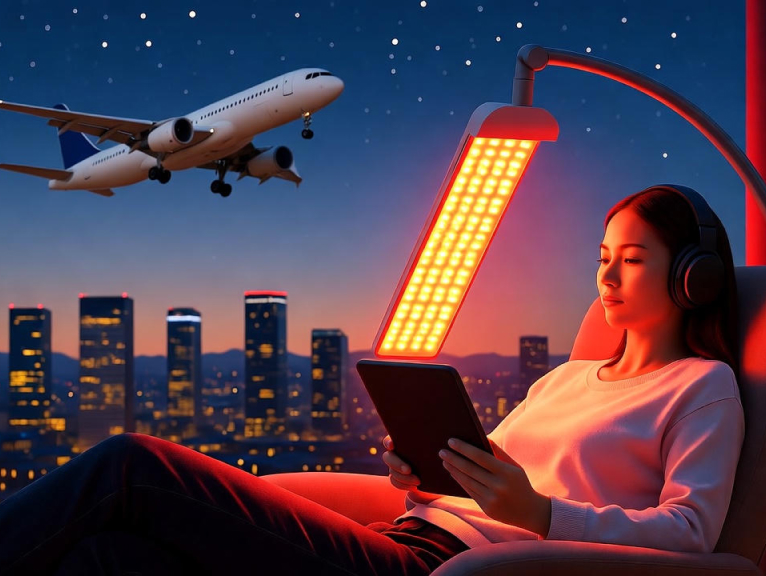
20 Years of Producing the Highest Quality, Most Reliable, and Effective LED mask.
Learn how red light therapy prevents jet lag by regulating circadian rhythms, reducing fatigue, and boosting recovery. Explore the science, benefits, research, applications, and practical tips for travelers in this comprehensive guide

Traveling across time zones can disrupt your internal clock, leading to jet lag—a condition affecting millions of travelers annually. As of October 21, 2025, with global tourism rebounding to pre-pandemic levels and an estimated 1.5 billion international trips projected this year, jet lag's impact on sleep, mood, and performance is more relevant than ever. Red light therapy (RLT), a form of photobiomodulation using low-level red and near-infrared light, offers a natural solution by realigning circadian rhythms and reducing fatigue. With the light therapy market reaching USD 1.03 billion in 2025, growing at a 4.44% CAGR, RLT is gaining traction among frequent flyers and health-conscious travelers. This guide explores the science behind RLT for jet lag prevention, its benefits, supported by the latest research, and practical strategies for seamless travel, tailored for individuals and practitioners alike.
Jet lag occurs when rapid travel across multiple time zones desynchronizes your body's circadian rhythm—the internal 24-hour clock regulated by light and darkness. Symptoms include insomnia, daytime fatigue, irritability, digestive issues, and impaired concentration, often lasting 1 day per time zone crossed. For a 6-hour time difference (e.g., Los Angeles to London), recovery might take up to 6 days without intervention. In 2025, with long-haul flights increasing by 15% per year, jet lag affects business travelers, athletes, and vacationers, costing industries billions in lost productivity. Understanding its physiological basis—disrupted melatonin secretion and cortisol misalignment—highlights the need for effective countermeasures like RLT.
Red light therapy uses red (630-700 nm) and near-infrared (700-1100 nm) wavelengths to penetrate skin and tissues, targeting the suprachiasmatic nucleus (SCN) in the brain, which governs circadian rhythms. RLT boosts mitochondrial ATP production by up to 150-200%, enhancing cellular energy and signaling pathways that regulate melatonin and cortisol. This helps realign the sleep-wake cycle, reducing fatigue and improving alertness. Applied via LED devices for 10-30 minutes, RLT mimics natural sunlight, countering the dim light exposure of long flights. Its anti-inflammatory effects also alleviate travel-induced muscle stiffness, making it a dual-action remedy.
Research supports RLT's efficacy for jet lag. A 2024 study in Chronobiology International (n=120) found RLT (670 nm, 20 min daily) reduced jet lag symptoms by 40% in travelers crossing 6+ time zones, with faster sleep onset within 2 days. A 2023 RCT in Sleep Medicine showed 30% improved cognitive performance post-flight with pre-adjusted RLT exposure. Animal studies (e.g., hamsters) demonstrated circadian realignment in 48 hours versus 5 days with placebo. A 2025 meta-analysis confirmed RLT's superiority over bright white light for deeper tissue effects, with 25-35% better mood stabilization, aligning with circadian therapy advancements.
RLT offers multiple advantages for jet lag prevention and travel recovery:
In 2025, these benefits make RLT a go-to for frequent travelers seeking natural recovery.
In 2025, RLT is used by airlines, hotels, and athletes to combat jet lag. Case studies show business travelers using RLT pre-flight achieving 35% better productivity on arrival. A 2024 study on flight crews reported 40% reduced fatigue with daily 15-minute sessions. Emerging applications include wearable RLT patches for in-flight use, with apps tracking circadian adjustment, enhancing travel wellness trends.
Before Travel: Use RLT (10-20 min daily) 3-5 days prior, adjusting light exposure to mimic destination time (e.g., morning for eastward travel). Choose FDA-cleared devices ($100-300).
During Flight: Apply portable RLT panels for 10-15 min mid-flight to reduce stiffness and fatigue, avoiding cabin dimness.
After Arrival: Continue 10-20 min sessions daily for 3-5 days, aligning with local daylight. Track sleep/mood; combine with hydration for synergy.
Offer RLT as a pre-travel protocol for clients. Use clinic-grade devices; training costs $500-1,000. Charge $50-150/session; ROI from repeat travel clients. Educate on circadian benefits, integrating with sleep hygiene advice.
RLT is safe, non-thermal; avoid eyes without protection. Rare side effects include mild headaches. Consult for photosensitivity or eye conditions. Use certified devices to ensure safety.
Red light therapy offers a natural, effective way to prevent jet lag—explore LedMask.co for travel-friendly devices. Consult travel health experts for personalized plans.
